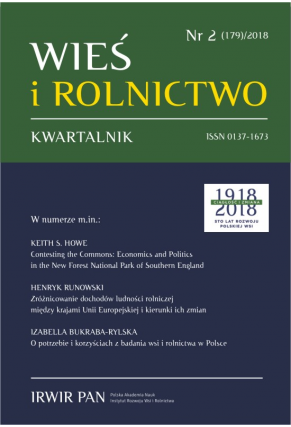Rural Development Policy in Poland (and in the EU) – A Needless Expense or a Must?
DOI:
https://doi.org/10.53098/wir.2018.2.179/09Keywords:
new challenges, rural development policy, the Common Agricultural Policy, territorial cohesionAbstract
Rural development policy is the answer to the changing role and place of agriculture in the economic structure. Over 75% of those employed in rural areas in Poland do not have any relations with agriculture any more, while generating their incomes from work in off-farm sectors. The objective of the authors’ considerations in this paper is to argue for an effective and sound rural support policy for the rural Poland and Europe, particularly in the area of off-farm job creation. The main conclusion of the authors is the need for changing rural development paradigm so that to enable active use of available endogenous and exogenous resources of rural areas, which is absolutely necessary in order to face the global challenges. The analysis is based on the literature and studies elaborating on the framework of rural development policy in the European Union and Poland as well as on the authors’ own research.References
AgraFacts, nr 01–18, 10.01.2018. DOI: https://doi.org/10.1055/a-0573-1832
A better future for Europe’s rural areas. (2017). Rada Europy. Raport CG33(2017)16 final, 19.10.2017, https://rm.coe.int/a-better-future-for-europe-s-rural-areas-governance-committee-rapporte/168074b728 [dostęp: 30.06.2017].
Cork 1.0 Declaration (1996). Towards an integrated rural development policy. http://ec.europa.eu/agriculture/rur/leader2/dossier_p/en/dossier/cork.pdf [dostęp: 30.06.2017].
Cork 2.0 Declaration. (2016). A Better Life in Rural Areas. https://ec.europa.eu/agriculture/sites/agriculture/files/events/2016/rural-development/cork-declaration-2-0_en.pdf [dostęp: 30.06.2017].
Draft report on the next MFF: Preparing Parliament’s position on the MFF post 2020 (2017/2052(INI)), Committee on Budgets, European Parliament, 10.01.2018.
Drygas M. (2016). Wsparcie rozwoju obszarów wiejskich w Polsce w ramach Wspólnej Polityki Rolnej UE. Studia Biura Analiz Sejmowych Kancelarii Sejmu, 4 (48), 101–122.
Drygas M., Nurzyńska I. (2015). Zrównoważona intensyfikacja – mit czy realna szansa? W: Ł. Hardt, D. Milczarek-Andrzejewska (red.). Ekonomia jest piękna? (s. 336–350). Warszawa: Wydawnictwo Naukowe Scholar.
Falkenberg K. (2016). Sustainability Now! A European Vision for Sustainability. European Political Strategy Centre, 18.
Fresco L.O., Poppe K.J. (2016). Towards a Common Agricultural and Food Policy. Wageningen. DOI: https://doi.org/10.18174/390280
The Future of Food and Farming, Communication from the Commission to the European Parliament, the Council, the European Economic and Social Committee and Committee of the Regions. European Commission, Brussels 29,11,2017, COM (2017) 713 final.
Halamska M. (2013). Wiejska Polska na początku XXI wieku. Rozważania o gospodarce i społeczeństwie. Warszawa: Wydawnictwo Naukowe Scholar.
Kłodziński M. (2011). Rozwój poza rolniczej przedsiębiorczości wiejskiej. W: A. Bołtromiuk (red.). Uwarunkowania zrównoważonego rozwoju gmin objętych siecią NATURA 2000 (s. 213–240). Warszawa: Instytut Rozwoju Wsi i Rolnictwa PAN.
The need for a White Paper on Rurality from a local and regional perspective. For a European rural agenda after 2020. European Committee of the Regions. Commission for Natural Resources, Brussels, styczeń 2017.
A new modern Multiannual Financial Framework for a European Union that delivers efficiently for its priorities post – 2020, Communication from the Commission to the European Parliament, the European Council and Council. European Commission, Brussels 14.02.2018, COM (2018) 98 final.
Nurzyńska I. (2016). Przyczyny i przejawy peryferyjności obszarów wiejskich w Polsce. Wieś i Rolnictwo, 2, 123–139. DOI: https://doi.org/10.53098/wir022016/05
Nurzyńska I. (2018). The Role of the CAP in Stimulating Rural Jobs, artykuł przyjęty do druku w Journal of Agribusiness and Rural Development.
OECD (2006). The New Rural Paradigm: Policies and Governance. Paris. DOI: https://doi.org/10.1787/9789264023918-en
OECD (2016). OECD Regional Outlook 2016. Productive Regions for Inclusive Societies. Paris: OECD Publishing. http://www.oecd.org/cfe/regional-policy/rural-policy-3.0.pdf [dostęp: 30.06.2017].
Reorientation of EFARD funding after 2020 (EFARD – RESET). Saxon State Ministry of the Environment and Agriculture, 21.06.2016, Dresden.
Rural proofing. Practical guidance for access impact s of policies on rural areas. Department of Environment, Food and Rural Affairs, 2017.
Van der Ploeg J.D. (2016). After CAP Towards an integrated rural development policy 2.0. Opublikowane 31.10.2016, ARC.
Van der Ploeg J.D. et al. (2000). Rural Development: From Practices and Policies towards Theory. Sociologia Ruralis, 40 (1), 391–408, http://onlinelibrary.wiley.com/doi/10.1111/1467-9523.00156/epdf [dostęp: 5.05.2017]. DOI: https://doi.org/10.1111/1467-9523.00156
Wilkin J. (2008). Ewolucja paradygmatów rozwoju obszarów wiejskich. Wieś i Rolnictwo, 3 (140), 18–28.
Downloads
Article file downloads
Pages
How to Cite
Issue
Section
License
Copyright (c) 2018 Wieś i Rolnictwo

This work is licensed under a Creative Commons Attribution 4.0 International License.






